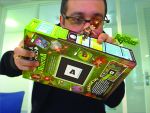Reality of interactive packaging

Eric Seiberling solution experience director for consumer packaged goods and retail industry at Dassault Systèmes explains the ideas behind some new and potential technology and its implications for the print, converting and packaging industries
With the application of technology packaging can give consumers immediate answers to their key needs when they are at the shelf: “What would I look like if I use this product?” Can I trust this brand? “Will I be disappointed when I get the product home?” Packaging that could demonstrate product promises accurately and with more information would greatly assist consumer’s buying decisions.
In the future it may be possible to produce packaging that goes far beyond what can be done today. Although current technology exists to engineer interactive packaging, in reality the cost per pack would be prohibitive. However costs are likely to reduce and if companies build the right foundations now they will be in a position to take advantage of future innovations more readily.
Today the concept of interactive packaging could be brought to life through combining a smartphone app with physical packaging. Most people mix online and in-store shopping and in response innovative brands are using new technologies to create consistent retail experiences across physical and virtual packaging formats. Nestlé deploys interactive 3D technology on millions of cereal packages in Europe, allowing consumers to use it as part of an online gaming experience. Promotions such as these see large percentage sales increases and improved brand recognition and loyalty.
A current major concern for the converting and packaging industries is how to combine the first (in-store) and second (in use) moments of truth ensuring that product packaging delivers on its promises.
Intelligent packaging could provide more accurate functional, logical and physical product impressions. These would help people make better-informed purchase decisions that lead to greater brand satisfaction. As a foundation to capitalising on future innovations brand owners, designers, copywriters, packaging manufacturers, converters and printers need to be connected via a single source of information within a social enterprise. This allows them to efficiently collaborate on new ideas. Having that level of organisation in place leads to time saving and more refined and advanced processes and products – and more time for creativity
Multi-media packaging
Harmonising designs globally and incorporating for example, sustainability and chemical interaction criteria collaboratively helps make designs that ‘wow’ consumers. It also helps brands work better in more territories across the world. A further bonus is that the money saved through implementing innovations can be used for further development. Future interactive packaging that helps people plan their diet, improve their appearance or maintain their home more efficiently are all possible with the right collaboration software. As mobile technology reduces the distance between physical and digital shopping and social networking becomes more prevalent, technology can create stronger connections between brands and their customers. Using new converting, print and packaging innovations online and physical brand experiences can merge for greater customer satisfaction.
Deploying collaboration technology allows converting and packaging businesses to move toward a future of brand consistency across multiple formats.
They can bridge diverse media while taking advantage of emerging industry developments including interactivity, 3D, avatar technology, social media and social enterprise developments.
Dassault Systemes
T: +33 1 61626162

